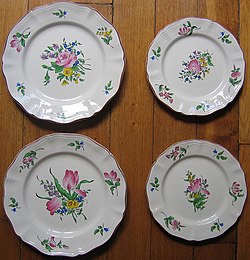The history of tin glazes in the Islamic world is disputed. One possible reason for the earlier production of tin-glazed wares could be attributed to the trade between the Abbasid Empire and ancient China from the 8th to 9th century onwards, resulting in imitation of white Chinese stoneware by local Islamic potters. [12] Another might be local glaze-making rather than foreign influence, supported by the similarity between the chemical and microstructural features of pre-Islamic white opaque glazes and that on the first tin-opacified wares [10]
Manufacturing process and colours
Though the recipe of tin glazes may differ in different sites and periods, the process of the production of tin glazes is similar. Generally speaking, the first step of the production of tin glazes is to mix tin and lead in order to form oxides, which was then added to a glaze matrix (alkali-silicate glaze, for example) and heated. [19] After the mixture cooled, the tin oxide crystallises as what has been mentioned above, therefore generates the so-called white tin-opacified glazes. Besides, the body of tin-opacified wares is generally calcareous clays containing 15-25% CaO, of which the thermal expansion coefficient is close to that of tin glazes, thus avoid crazing during the firing process. [20] [21] On the other hand, the calcareous clay fired in an oxidising atmosphere results in a buff colour, thus lower the concentration of tin oxide used [22]
The white opaque surface makes tin glaze a good base for painted decoration. The decoration is applied as metallic oxides, most commonly cobalt oxide for blue, copper oxide for green, iron oxide for brown, manganese dioxide for purple-brown and antimony for yellow. Late Italian maiolica blended oxides to produce detailed and realistic polychrome paintings, called istoriato. To these oxides modern potters are able to add powdered ceramic colours made from combinations of oxide, sometimes fritted. [23] In the sixteenth century, the use of subtle and blended colours which were not strong enough to penetrate the opaque glaze made the delicate control of tonal values possible, and the painting therefore had to be done on the glaze surface, which then becomes a common manner of painting on tin-glazed wares. [1]
This method was used until the 18th century, and is often called by the French name grand feu in English. The wares were fired twice, firstly just the clay body, then again after the glaze and painted colours were added. The colours applied on top of the glaze blended into it during firing (the technique thereby differing from underglaze painting used with transparent glazes). [24] The disadvantage was that only a narrow group of pigments produced good colours after firing at the relatively high temperatures of up to 1,000 °C (1,800 °F). These included cobalt blue, manganese dark purple, copper green, antimony yellow, and the very tricky iron reds and brown, which only some potters were able to make as a good red. [25]
In the 18th century overglaze enamels began to be used in the same way as on porcelain; this technique is often called petit feu in English when talking about faience (the Italian name is piccolo fuoco). A much wider range of colours was possible, but after the fired and glazed wares were painted a third firing was required, at a lower temperature of perhaps 750 and 850 °C (1,400 and 1,600 °F). [26]
In modern versions, the pottery vessels are biscuit fired, usually between 900 and 1,000 °C (1,700 and 1,800 °F). The fired vessel is dipped in a liquid glaze suspension which sticks to it, leaving a smooth and absorbent surface when dry. On this surface colours are applied by brush, the colours made from powered oxides mixed with water to a consistency of water-colour paint, sometimes with the addition of a binding agent such as gum arabic. The unfired glaze absorbs the pigment like fresco, making errors difficult to correct but preserving the brilliant colors of the oxides when fired. The glazed and decorated vessels are returned to the kiln for a second firing, usually between 1000 and 1120 °C (the higher temperatures used by modern potters). Lustered wares have a third firing at a lower temperature, necessitating a delicate control of the amount of oxygen in the kiln atmosphere and therefore a flame-burning kiln.
Traditional kilns were wood firing, which required the pots to be protected in the glaze and luster firings by saggars or to be fired in a muffle kiln. Except for those making luster ware, modern tin-glaze potters use electric kilns.
The recrystallisation of tin oxide during the firing provides evidence of the slightly different methods of different production sites, as the crystal size, the distribution and the concentration may be influenced. For instance, the analysis of the 14th century Islamic tin glazes from eastern Spain indicates that these samples may be produced by non-fritting methods, as the heterogeneous distribution of tin oxides may be the remains of original grains of tin oxides. [27]
The interaction between glaze and body also give clues to different handling and firing processes. As mentioned above, tin glaze suspension is applied to bisque or biscuit body made of calcareous clay with high content of calcium oxide. This could be inferred from the absence of trapped glaze bubbles. If it is applied to an unfired body, the calcium carbonate will decompose, generating carbon dioxide, the releasing of which from the body to the glaze results in trapped bubbles in the glaze layers.



